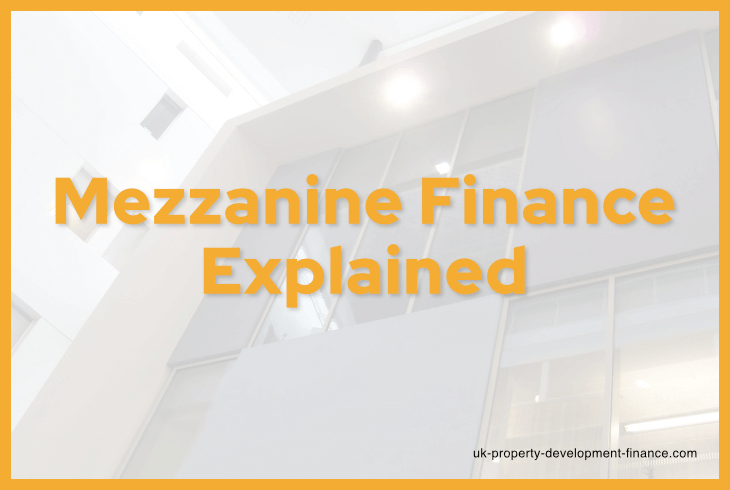Mezzanine Finance is a debt and equity hybrid which enables a lender to convert the debt into equity. Mezzanine finance is a second charge debt, is higher risk, and subsidises a shortfall in cash at hand. We will break down this type of financing into easy-to-understand terms, focusing on time frames, the costs involved, and why you would opt to use mezzanine financing for your property development project.
Mezzanine Finance, why would you use it?
Mezzanine Finance is a second-charge debt that is used by property developers to access additional funds when they need more capital to complete a project. This type of finance helps to provide a bridge between the funds offered by a lender and the capital of the borrower. The party providing the mezzanine finance would take a second charge over the development, similar to how a second charge loan providers would secure their second charge behind the mortgagee assuming there is adequate equity in the borrower’s home.
How does Mezzanine Financing work?
Typically, mezzanine finance would be accessed for three main reasons:
- To reduce the level of deposit required
- To bridge the gap in funding
- To assist the borrower in retaining as much capital as possible, so this can be utilised for new projects.
Once accepted, the money may be made available at the beginning of the project if it is needed as a deposit, or if it is to be used to purchase a site. Alternatively, it may be released during the project when it is needed by the developer. This flexibility is one of the key benefits of this type of finance. A usual mezzanine finance arrangement would see the senior lender provide 70% of the development funding, while the mezzanine finance lender would provide an additional 15-20% of capital, with the remaining balance coming from the developer.
The mezzanine finance lender secures the funding by taking a second charge on the property development. This way, the lender will recover the finance provided plus interest at the end of the loan term, this can be achieved in several ways, which we will discuss in the next section. Mezzanine Finance is a short-term loan and most lenders would expect the debt to be settled within 12-24 months.
What are the costs involved?
A mezzanine finance lender would look to achieve a return on investment in the following ways.
- A share of the profits at the end of the project
- Combined either a high rate of interest, or by agreeing to a set fee with the borrower
Should the development be successful, then the lender will receive interest repayments in addition to equity, regardless of whether the loan is paid back. This means that the more profitable a development is, the larger the stake the lender has in your business. The reason for this high rate of interest is that the level of risk for the mezzanine lender is also high, as it is a second charge debt that falls behind the initial senior loan. Mezzanine finance lenders usually offer very flexible interest repayment plans (monthly, quarterly, rolled up or annually).
How much can I borrow from a Mezzanine Finance Provider?
Mezzanine finance providers will let applicants borrow up to 90% of the project’s loan to cost, providing the borrower is eligible, or up to 70% of the project’s loan to gross development value. In terms of the maximum a developer can borrow, some lenders place a cap in the region of £3m, while some lenders have no cap at all. Many lenders also have a minimum loan amount requirement that can range between £75k and £250k. In some cases, the lender may also require a personal guarantee or additional collateral to secure the loan, although this is often not a requirement and in respect of surety may only require minimal additional collateral.
What is the eligibility criteria?
Like any type of finance, most applications will be assessed individually and on each project’s own merits, but almost every lender will check for primary eligibility criteria before approving any loan.
- Has planning permission been granted?
- Is first charge funding already in place?
- Does the developer have the required experience for such a project?
- Is the project a worthwhile investment that offers a viable return on investment?
How long does it take to secure Mezzanine Finance?
Unfortunately, mezzanine finance can be rather complex and sometimes take a few months to arrange, as this type of loan is commonly associated with large-scale development projects, with many factors to consider. Therefore, it is recommended to expect an extended arrangement process when planning your development project.
Mezzanine Property Finance – Advantages & Disadvantages
Advantages
- Mezzanine finance also helps developers retain capital that can be used for future projects.
- This is a very flexible form of finance that can be tailored to individual projects.
- The interest payments are tax deductible and can be deferred/postponed to a later date.
- Successful projects can sometimes be given the option to restructure the arrangement to reduce the interest rate.
- Mezzanine finance is more cost effective than a Joint Venture or equity structure
Disadvantages
- Choosing this type of finance means reducing the amount of profit at the end of the project.
- Interest rates are much higher when compared to traditional loans.
- As it is an additional loan, this means additional arrangement fees.
- This type of finance can be protracted on larger developments and take a long time to arrange.
- Mezzanine finance is an additional debt on top of the initial senior debt/loan.
If you are unfamiliar with any of the terms used in this article, then feel free to browse our development finance glossary for easy-to-understand descriptions and jargon free terms. Further reading and reference.

